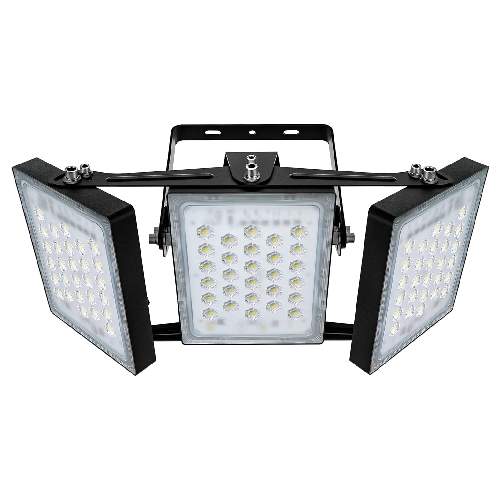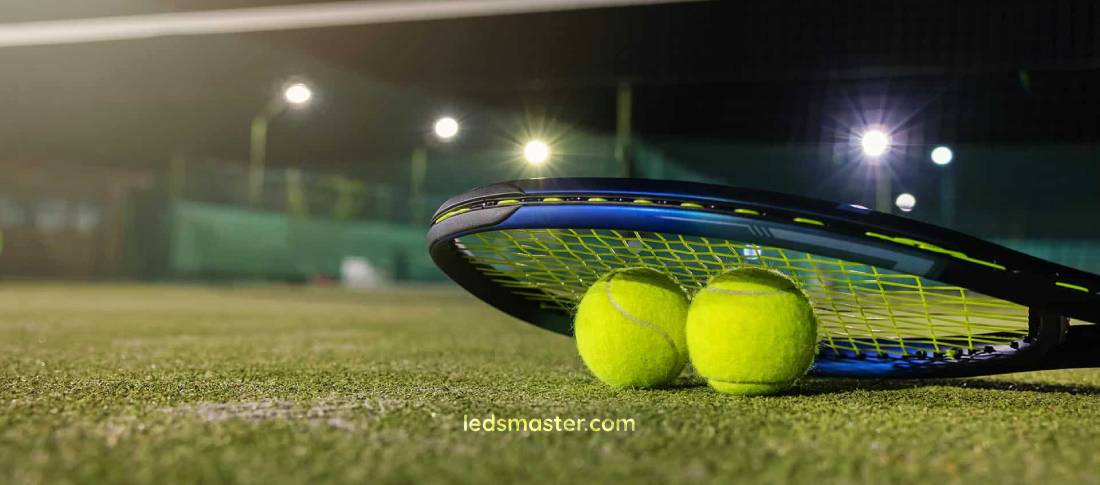
Designed for optimal visibility and performance, our lighting products ensure every game is played in perfect conditions, whether indoors or under the stars. Upgrade your tennis court with energy-efficient, durable, and high-quality illumination today.
Get your complimentary lighting design today
A crucial element in achieving fairness, visibility, and enjoyment is effective lighting, especially for evening matches or indoor venues. LED lighting has become the preferred choice for tennis courts, offering numerous advantages such as energy efficiency, longevity, and superior performance. This article explores the different facets of tennis court lighting, emphasizing LED technology, appropriate fixtures, optimal lux levels, lighting design, and the benefits of transitioning to LED lighting systems.
Table of Contents
ToggleLED fixtures come in various forms, each suited to different lighting needs and conditions. For tennis courts, several types of LED fixtures are commonly used, each offering distinct advantages:
Floodlights are a popular choice for tennis courts, providing broad and intense illumination. These fixtures are ideal for outdoor courts and large indoor arenas where high light levels are required to ensure visibility across the entire playing surface. Floodlights can be mounted on high poles around the court, ensuring even distribution of light without causing glare or shadows.
High mast lights are used in large sports complexes with multiple courts. These fixtures are mounted on very tall poles, often exceeding 30 meters, and can illuminate vast areas. High mast lights are particularly beneficial for tournaments and events where multiple courts need to be lit simultaneously, ensuring uniform brightness and visibility.
For indoor tennis courts, recessed lighting is a suitable option. These fixtures are installed within the ceiling structure, providing a sleek and unobtrusive lighting solution. Recessed LED lights offer uniform illumination and are often used in facilities where aesthetics and minimizing obstructions are crucial.
Wall-mounted LED fixtures are another option for indoor tennis courts. These lights are attached to the walls surrounding the court and can be angled to direct light precisely where needed. This type of lighting is advantageous for facilities with lower ceilings or where traditional overhead lighting is impractical.

Lux, the unit of illuminance, measures the amount of light that falls on a surface. For tennis courts, the optimal lux level depends on several factors, including the type of play (recreational or professional), indoor or outdoor setting, and the specific requirements of the venue.
For recreational tennis, a lux level of 300 to 500 is generally sufficient. This level provides adequate visibility for casual play while maintaining a comfortable lighting environment. Recreational facilities often opt for the lower end of this range to balance lighting quality with energy consumption.
Professional and tournament play requires higher lux levels to ensure players can see the ball clearly and react quickly. A lux level of 500 to 1,000 is recommended for competitive matches. This range ensures optimal visibility, reduces eye strain, and enhances the overall quality of play. For televised events, even higher lux levels may be necessary to accommodate camera requirements and ensure clear broadcast quality.
Indoor courts typically require higher lux levels compared to outdoor courts due to the absence of natural light. Indoor facilities should aim for a lux level of 600 to 1,000, depending on the level of play and specific needs of the venue. Outdoor courts, benefiting from natural daylight, can function effectively with lux levels ranging from 300 to 700.
Effective lighting design is crucial for ensuring that tennis courts are well-lit, safe, and comfortable for players and spectators. Several key factors must be considered in the design process:
Uniformity of lighting ensures that there are no dark spots or overly bright areas on the court. Uneven lighting can cause glare, shadows, and visual discomfort, impacting players’ performance. A uniformity ratio of 0.6 or higher is recommended, meaning that the minimum lux level should be at least 60% of the average lux level across the court.
Glare can be a significant issue in sports lighting, as it affects players’ ability to see clearly and react quickly. LED fixtures designed for sports applications often include features to minimize glare, such as specialized lenses, diffusers, and shielding. Positioning fixtures at appropriate angles and heights also helps reduce glare and improve visual comfort.
The color temperature of lighting affects how the light appears to the human eye. For tennis courts, a color temperature of 5000K to 6500K is ideal, providing a bright, daylight-like quality that enhances visibility. Additionally, a high Color Rendering Index (CRI) of 80 or above ensures that colors are rendered accurately, which is crucial for players to see the ball and lines clearly.
Energy efficiency is a significant consideration in lighting design, especially for facilities looking to reduce operational costs and environmental impact. LED fixtures are highly energy-efficient, consuming up to 70% less energy than traditional lighting systems. Incorporating smart controls, such as dimming and motion sensors, further enhances energy savings by adjusting lighting levels based on usage and occupancy.
Upgrading to LED lighting offers numerous benefits for tennis courts, making it the preferred choice for modern sports facilities:
LED lights provide bright, clear illumination, significantly improving visibility for players and spectators. The superior color rendering and uniform light distribution of LEDs ensure that the entire court is well-lit, enhancing the quality of play and reducing eye strain.
LEDs are incredibly energy-efficient, consuming far less power than traditional lighting systems. This efficiency translates to substantial cost savings on energy bills, making LED lighting a financially smart investment for sports facilities. Additionally, LEDs have a longer lifespan, reducing maintenance costs and the frequency of replacements.
LED fixtures are designed to withstand harsh environmental conditions, making them ideal for both indoor and outdoor tennis courts. They are resistant to vibrations, shocks, and temperature fluctuations, ensuring reliable performance and longevity. This durability is particularly beneficial for outdoor courts exposed to the elements.
LED lighting is environmentally friendly, as it consumes less energy and produces lower carbon emissions compared to traditional lighting systems. LEDs also contain no hazardous materials, such as mercury, making them a safer and more sustainable choice for sports facilities.
LED lights offer instant illumination without the warm-up time required by traditional lighting systems. This feature is particularly advantageous for sports facilities, allowing for immediate lighting adjustments as needed. Additionally, LED fixtures can be dimmed, providing flexibility in lighting levels based on the time of day, type of event, and specific needs of the venue.
Upgrading an existing tennis court lighting system to LED technology involves several steps to ensure a successful transition:
The first step in upgrading to LED lighting is a thorough assessment of the current lighting system and the specific needs of the facility. This assessment includes evaluating the existing fixtures, determining the required lux levels, and identifying any areas that need improvement.
Choosing the right LED fixtures is crucial for achieving optimal lighting performance. Factors to consider include the type of play (recreational or professional), indoor or outdoor setting, and specific requirements of the venue. Working with a lighting professional can help ensure that the selected fixtures meet the facility’s needs and provide the desired illumination levels.
Proper installation is essential for maximizing the benefits of LED lighting. This process involves replacing existing fixtures with LED counterparts, ensuring correct positioning and angles, and integrating any additional features, such as dimming controls and motion sensors. Professional installation ensures that the lighting system operates efficiently and effectively.
LED lighting systems require less maintenance than traditional lighting, but regular inspections and cleaning are still necessary to ensure optimal performance. Establishing a maintenance schedule and monitoring the system’s performance can help identify and address any issues promptly, ensuring that the lighting remains in top condition.
LED lighting has revolutionized the way tennis courts are illuminated, offering numerous benefits that enhance the playing experience, improve visibility, and reduce operational costs. By choosing the right fixtures, achieving optimal lux levels, and implementing effective lighting design, sports facilities can create a superior lighting environment that meets the needs of players, spectators, and event organizers. Upgrading to LED lighting is a smart investment that not only improves performance but also contributes to sustainability and long-term cost savings. Whether for recreational play or professional tournaments, LED lighting is the ideal choice for modern tennis courts.